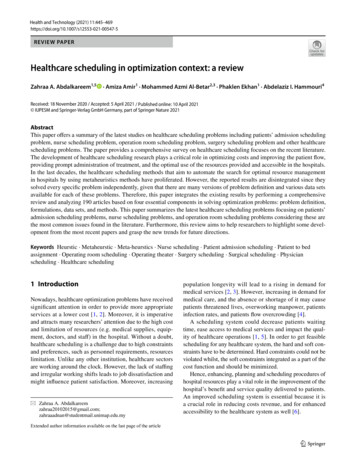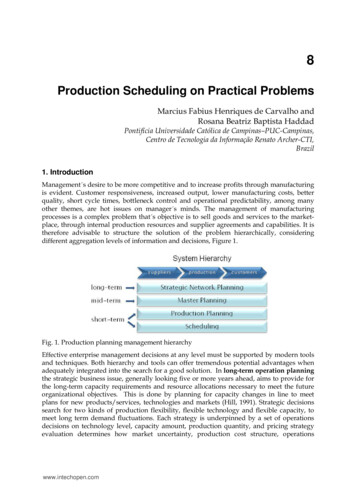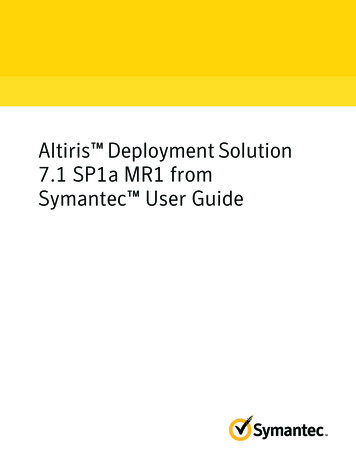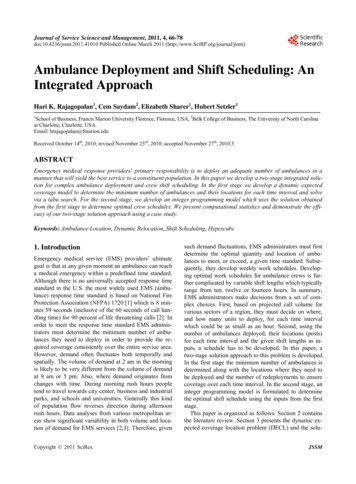
Transcription
Journal of Service Science and Management, 2011, 4, 66-78doi:10.4236/jssm.2011.41010 Published Online March 2011 (http://www.SciRP.org/journal/jssm)Ambulance Deployment and Shift Scheduling: AnIntegrated ApproachHari K. Rajagopalan1, Cem Saydam2, Elizabeth Sharer1, Hubert Setzler11School of Business, Francis Marion University Florence, Florence, USA; 2Belk College of Business, The University of North Carolinaat Charlotte, Charlotte, USA.Email: hrajagopalan@fmarion.eduReceived October 14th, 2010; revised November 23rd, 2010; accepted November 27th, 2010.5ABSTRACTEmergency medical response providers’ primary responsibility is to deploy an adequate number of ambulances in amanner that will yield the best service to a constituent population. In this paper we develop a two-stage integrated solution for complex ambulance deployment and crew shift scheduling. In the first stage we develop a dynamic expectedcoverage model to determine the minimum number of ambulances and their locations for each time interval and solvevia a tabu search. For the second stage, we develop an integer programming model which uses the solution obtainedfrom the first stage to determine optimal crew schedules. We present computational statistics and demonstrate the efficacy of our two-stage solution approach using a case study.Keywords: Ambulance Location, Dynamic Relocation, Shift Scheduling, Hypercube1. IntroductionEmergency medical service (EMS) providers’ ultimategoal is that at any given moment an ambulance can reacha medical emergency within a predefined time standard.Although there is no universally accepted response timestandard in the U.S. the most widely used EMS (ambulance) response time standard is based on National FireProtection Association (NFPA) 1720 [1] which is 8 minutes 59 seconds (inclusive of the 60 seconds of call handling time) for 90 percent of life threatening calls [2]. Inorder to meet the response time standard EMS administrators must determine the minimum number of ambulances they need to deploy in order to provide the required coverage consistently over the entire service area.However, demand often fluctuates both temporally andspatially. The volume of demand at 2 am in the morningis likely to be very different from the volume of demandat 9 am or 5 pm. Also, where demand originates fromchanges with time. During morning rush hours peopletend to travel towards city center, business and industrialparks, and schools and universities. Generally this kindof population flow reverses direction during afternoonrush hours. Data analyses from various metropolitan areas show significant variability in both volume and location of demand for EMS services [2,3]. Therefore, givenCopyright 2011 SciRes.such demand fluctuations, EMS administrators must firstdetermine the optimal quantity and location of ambulances to meet, or exceed, a given time standard. Subsequently, they develop weekly work schedules. Developing optimal work schedules for ambulance crews is further complicated by variable shift lengths which typicallyrange from ten, twelve or fourteen hours. In summary,EMS administrators make decisions from a set of complex choices. First, based on projected call volume forvarious sectors of a region, they must decide on where,and how many units to deploy, for each time intervalwhich could be as small as an hour. Second, using thenumber of ambulances deployed, their locations (posts)for each time interval and the given shift lengths as inputs, a schedule has to be developed. In this paper, atwo-stage solution approach to this problem is developed.In the first stage the minimum number of ambulances isdetermined along with the locations where they need tobe deployed and the number of redeployments to ensurecoverage over each time interval. In the second stage, aninteger programming model is formulated to determinethe optimal shift schedule using the inputs from the firststage.This paper is organized as follows. Section 2 containsthe literature review. Section 3 presents the dynamic expected coverage location problem (DECL) and the soluJSSM
Ambulance Deployment and Shift Scheduling: An Integrated Approachtion algorithm. Section 4 the presents the ambulance crewscheduling model. In Section 5 computational statisticsare discussed and in Section 6 the application of thetwo-stage approach with the aid of data from GreaterCharlotte area is analyzed as a case study. Conclusionsand some future work are outlined in Section 7.2. Literature ReviewEarlier models for ambulance coverage were deterministic, but, nevertheless they presented computational challenges for researchers. The advent of cheaper and fastercomputing during the 1990s, availability of fast commercial solvers such as CPLEX [4] and the development ofmeta-heuristics facilitated researchers in developing probabilistic, and therefore, more realistic models [5-11].For earlier developments readers are referred to the reviews by Shilling, Jayaraman, and Barkhi [12] and Owenand Daskin [13]. The latest developments in this fieldcan be found in Brotcorne, LaPorte and Semet’s comprehensive review [14].Probabilistic models incorporate the probability thatthe nearest ambulance(s) may not be available whenneeded. This uncertainty can be modeled using a queuingor simulation approach, or embedded into a math programming formulation. Daskin’s maximum expected coverage location problem (MEXCLP) model was amongthe first to explicitly incorporate the probabilistic dimension of the ambulance location model [15]. In contrast todeterministic models, Daskin assumed that all units operate independently and have the same busy probability , estimated a priori. With these simplifying assumptions Daskin computed the probability of a demand nodebeing covered as 1 k where k is the number of servers (ambulances) located within the time threshold thuscapable of being covered. He was able to develop an expression for expected coverage as h j 1 k , where hjis the demand at node j. Thus, given a fleet of ambulances MEXCLP maximizes the expected coverage subject to a response-time standard or, equivalently, a distance threshold. At about the same time, ReVelle andHogan proposed the maximum availability locationproblem (MALP) [16] where they also utilized a priorisystem wide busy probability to compute the number ofservers required to meet the availability requirement.The first wave of probabilistic models based on a mathematical programming approach utilized simplifyingassumptions such as all ambulances 1) operate independently and 2) have the same busy probability. However, there have been notable efforts towards relaxingsome of these assumptions. For example, with their second MALP formulation (MALP II), ReVelle and Hoganallow server busy probabilities to be different in variousneighborhoods, sectors of a given region but not location Copyright 2011 SciRes. 67specific. Ball and Lin [17] take a similar approach as inMALP but instead of computing server busy probabilitiesin their reliability model, they compute the probabilitythat a given demand point will not find an availableserver. The Probabilistic Location Set Covering Problem(PLSCP) formulated by ReVelle and Hogan [18] minimized the number of servers needed to guarantee coverage for a region. This model like MALP II uses neighborhood server busy probabilities. Marianov and ReVelle[19] extended PLSCP using the assumption of neighborhood probabilities in MALPII to formulate the QueuingProbabilistic Location Set Covering Problem (Q-PLSCP).They model each neighborhood as a multi-server losssystem and calculate the neighborhood busy probabilitiesa priori and then use it as an input in the model.True probabilistic models are based on spatially distributed queuing theory [20] or simulation [21], and theyare, therefore by definition, descriptive. These modelsare employed to evaluate the vehicle busy probabilitiesand other performance metrics of a given allocation ofambulances. Larson’s hypercube model [16,20,22] represents the most notable milestone for approaches using aqueuing framework. The hypercube model and its various extensions have been particularly useful in determining performance of EMS systems [7,20,23-30]. However, hypercube is computationally expensive. For mservers the number of simultaneous equations to solvewould be 2m. For fleet sizes of more than nine this approach would be computationally impossible to solvewith the present day computers. To solve this problemLarson developed an approximation to the hypercubemodel [22] which requires only m simultaneous nonlinear equations for m servers. One of the assumptions usedin Larson’s approximation is that service times are exponentially distributed and identical for all servers, independent of the demand they service. Jarvis generalizedLarson’s approximation for loss systems (zero queue) byallowing service time distributions to be of a general typeand may depend on both server and customer [31].Most of the OR work in this area has been for longterm planning where EMS managers make decisions onthe location of ambulance bases [7]. Since a long termperspective was taken, fluctuations in demand in anygiven day were overlooked and instead peak demandperiods were used as an estimate for demand. However,in reality, demand is not static but fluctuates throughoutthe week, by the day of week, and by the hour within agiven day [7,32]. Redeployment models however look atthe operational level decisions managers make daily, oreven hour by hour, in an attempt to relocate ambulancesin response to demand fluctuations by time and space.There have been two earlier papers on relocation in theEMS literature [11,33]. Repede and Bernardo [33] exJSSM
68Ambulance Deployment and Shift Scheduling: An Integrated Approachtended MEXCLP for multiple time intervals to capturethe temporal variations in demand and unit busy probabilities, hence, they called their model TIMEXCLP.Their application of TIMEXCLP to Louisville, Kentuckyresulted in an increase of coverage while the averageresponse time decreased by 36%. The most recent andcomprehensive dynamic relocation model developed byGendreau et al. [11], is the dynamic double standardmodel at time t (DDSMt). The objective of this model isto maximize backup coverage while minimizing relocation costs. There are several important considerationsincorporated into this model. While the primary objectiveis to maximize the proportion of calls covered by at leasttwo ambulances within a distance threshold, the modelpenalizes repeated relocation of the same ambulance,long round trips, and long trips. The model’s input parameters are updated each time a call is received andDDSMt is then solved. To solve this complex model,particularly at short time intervals, Gendreau, Laporteand Semet [11] developed a fast tabu search meta heuristic implemented using eight parallel Sun Ultra workstations. To test the quality of solutions found by the tabusearch they solved 33 random problems with CPLEX,and then compared the results, which showed that theworst case departure from optimality was merely 2%.Using real data from Montreal, their tests showed that thealgorithm was able to generate new redeployment strategies for 95% of all cases.Surprisingly ambulance shift scheduling received verylittle attention in the literature [7] with the exception anearly study by of Trudeau et al. [34] and two recent notable papers [35,36]. Trudeau et al. conducted a rathercomprehensive study for the planning and operation ofambulance services which included demand forecastingby three hour time blocks and using these forecasts forcrew scheduling. However, spatial variability of calls forservice was not included in their forecasts. Spatial variability is important because often ambulances are postedin various sectors of the region to ensure the responsetime standard is met. Recently, Erdogan et al. [35] approached the combined shift scheduling and ambulancelocation developing two integer programming modelswhere the first model stressed maximizing the aggregateexpected coverage and the second model used a lexicographic multi-objective approach to ensure equity usingminimum hourly coverage requirements. They developeda tabu search to solve these models and showed that thesecond model can generate equitable coverage even under tougher budgetary conditions. The proposed approach in this paper differs from Erdogan et al.’s approach in both stages [35]. In the first stage the objectivehere is to minimize the total number of ambulances required to meet the expected coverage for every time peCopyright 2011 SciRes.riod, hence implicitly minimizing vehicle operating costs.Also in [35] station capacities are considered where inthe present study (based on real data and current practices in the region) a dynamic deployment practice isassumed hence ambulances can be deployed to any node,including fixed stations, at anytime. The second stage ofthe present approach is also significantly different than in[35] where the present study finds the optimum numberof shifts with varying lengths to directly implement thedeployment plan generated from the first stage. Li andKozan [36] developed a two stage shift scheduling modelfor an ambulance station (managing multiple ambulances)over a month long planning horizon. In the first stagethey minimize the volatility of ambulance supply anddemand where the demand for ambulance staff for agiven period must be less than or equal to working staffduring the same period. In the second stage they minimize the total number of working hours, essentiallyminimizing personnel costs. Their staff allocation modelincludes constraints that limit working hours per shift,limit consecutive night shifts and maximum of consecutive shifts (hours worked) while minimizing the totalnumber of crews assigned during the planning horizon.They use LINGO to solve a case study with 8-, 10- and12-hour shifts to generate a monthly schedule with a staffof 50 at an ambulance station [36]. Li and Kozan’s [36]approach is significantly different from the present study(and Erdogan et al.’s [35] study) where they consider thenumber of ambulances to be deployed for the entire daywithout considering time of the day variations in demandand correspondingly supply also.3. Dynamic Expected Coverage LocationProblemIn this section, a new model is formulated to determine theminimum number of ambulances that meet, or exceed, apredetermined expected coverage requirement for dynamic redeployment of ambulances in response to fluctuating demand. The solution from this stage, which is thenumber and location of ambulances per time interval, willbe the input and constraints for the second stage whenactual crew schedules are developed. Here, Daskin’s expected coverage metric [15] is incorporated as a hardconstraint that the EMS agency must meet. This indeed isthe case of many municipalities in the U.S. [7] and specifically in the case of Charlotte, North Carolina 90 % ofdemand must be reached within 10 minutes 59 seconds.Although Daskin’s MEXCLP model and the definition ofexpected coverage represent an important milestone in thedevelopment of probabilistic models, MEXCLP is knownto overestimate expected coverage and in general it isshown not to be very accurate [23,28], largely due to theJSSM
Ambulance Deployment and Shift Scheduling: An Integrated Approachassumptions of no server cooperation and same systemwide busy probability. This model is inspired by Marianov and ReVelle’s Q-PSCLP [37] where they utilizeneighborhood based busy probabilities instead of a system-wide busy probability. However, these probabilitiesare still computed a priori. This model is extended bycomputing server and location specific busy probabilitiesusing Jarvis’ hypercube approximation [31]. This permitsthe expected coverage resulting from a given deploymentto be computed more accurately. This model also incorporates the dynamic nature of the problem where ambulance fleet size and locations must be determined in response to fluctuating demand throughout the day.The dynamic expected coverage location (DECL)model is formulated to deploy minimum number of ambulances to guarantee a system wide coverage under dynamic demand conditions. Let, t be the index of timeintervals from 1 to T, hj,t be the fraction of demand atnode j at time interval t, n be the number of nodes in thesystem, ct be the minimum expected coverage requirement at time t, ρk,t be the busy probability of the kth preferred server for a given demand node at time interval t,ρt be the average system busy probability at time intervalt, m be the total number of servers available for deployment and set Nj is the set of all servers that can covernode j. To be able to compute server specific busy probabilities, each server located at a given node must beidentified. Hence, the main decision variable is definedas follows: 1 if server k is located at node j at time t.x j , k ,t 0 otherwiseConversely, the servers who cover node j are trackedwith the following decision variable: 1 if node j is covered by server k at time ty j , k ,t 0 otherwiseIn developing expressions for the expected coveragerequirement constraint, location-specific server busy probabilities, ρk, are computed using Jarvis’ hypercube approximation algorithm and the correction factor (Q factor). Note that the Q factor adjusts the joint probabilitiesfor server cooperation. Thus, the system-wide expectedcoverage which is a constraint, can be written asnk 1m Q Z , t , k 1 h j ,t yk , j ,t 1 k ,t l ,t .j 1 k 1l 1Minimize:TnmZ x j , k ,tt 1 j 1 k 1Subject to:Copyright 2011 SciRes.(1)mm x j , k N , t y j , k , tjk 1n69 j , t(2)k 1k 1m Q Z , t , k 1 h j ,t yk , j ,t 1 k ,t l ,t ctj 1 k 1 tl 1(3)nm x j ,k ,t m t(4)j 1 k 1x j , k ,t , yk , j ,t 0,1 k , j , t(5)The objective function (1) minimizes the total numberof ambulances over multiple periods and constraint (2)counts the number of ambulances that cover each nodeand tracks which server’s cover each demand node, while(3) ensures that system-wide total expected coverage isgreater than the pre-specified required coverage. Constraint (4) sets the maximum number of servers in thesystem, and (5) are integrality constraints. To solve (1)(5), the parameters ρk and Q(m,ρ,k-1) in (3) must be firstdetermined. Their values are dependent on the decisionvariable xjk, and must therefore be calculated at run time,and updated every time server locations change. Theproposed model cannot therefore be solved by ILPsolvers. Fortunately, the structure of this problem makesit possible to solve using heuristic algorithms.3.1. The AlgorithmThere is strong evidence that carefully crafted meta-heuristics in the location domain produce excellent results[5,8,9,11,35,38-42]. Most models in the literature that aresolved using meta-heuristics have one objective such asto find the maximum coverage with a given set of servers.The main objective of the model presented here is to determine the minimum number of ambulances which canmeet (or exceed) the coverage requirements. Since thesystem-wide coverage depends on ambulance locations,the secondary search objective is to determine the locations which will yield the maximum coverage given afleet size. To solve for these two interdependent objectives a search heuristic called the Incremental SearchAlgorithm (ISA) is developed. ISA has a hierarchicalstructure where the first objective of finding the minimum number of servers can be viewed as the mainsearch (outer) loop, with the second objective, whichyields the maximum coverage, nested as an inner searchloop. The main search (outer) loop increments or decrements the fleet size based on the results from the innerloop (meets or does not meet the average requirements).For the inner loop of the ISA a variation of ReactiveTabu Search (RTS) [43] is implemented in which Jarvis’algorithm is embedded to compute server specific workloads and coverage statistics. For the ISA a one dimenJSSM
70Ambulance Deployment and Shift Scheduling: An Integrated Approachsional data structure (an array) of size mt*t t is usedwhere mt is the number of response units (servers) and tis the number of time intervals. The array starts with theexpected coverage and the server locations for time interval 1 and then continues with the expected coverageand location of the servers for all time intervals.The ISA works in the following way: At iteration 0,solve for mt t t t where mt is the number ofservers (fleet size) at time t, t is the arrival rate at timet, ρt is the average busy probability of servers and t isthe service rate at time t. The value of m, is the initialsize of the search vector. For t 1 randomly generateserver locations and evaluate the expected coverage using the Jarvis’ algorithm within Equations (2) and (3).RTS is used to find the set of locations which gives usthe best coverage. If the best coverage found by RTS isless than the required coverage, then increase the numberof servers and RTS is run again with the new set of servers. This process continues until the coverage constraintis met. If the coverage for the initial number of servers,after running RTS, is more than the required coverage,the number of servers is reduced by one. Again RTS isrun until the coverage drops below the required coverage,in which case the previous solution is the required number of servers. The initial solution for all time periodswhere t 1 is the best solution found in t 1. This approach recognizes that EMS demand shifts gradually involume and space and linking the time periods significantly reduces the solution times.3.2. Reactive Tabu SearchA variation of Tabu Search called Reactive Tabu Search(RTS) [43] is implemented to obtain optimal or near optimal results. In RTS the tabu list is created based onfeedback throughout the search. Similar to Gendreau et al.[40] the basic operation of this algorithm is moving anambulance from node i to node j, where node j is the bestlocation within the neighborhood which results in increased coverage. The term, neighborhood for this studyis the eight nodes immediately surrounding a selectednode. All moves (i, j pairs) are stored in the long termmemory. The initial tabu list size is set equal to one. If amove recorded in the long term memory occurs again,the tabu list size increases to include that move, and ifthe same move in the tabu list is not repeated for 2*miterations, where m is the current number of servers. Thatmove is then removed from the tabu list. For a given fleetsize, the first ambulance is selected to be moved to thebest node in the neighborhood. The best node is selectedbased on the best coverage as calculated by Equation (3).This process constitutes the first iteration. Next, the second ambulance is selected for the basic neighborhoodsearch, and the process repeats until the last ambulance isCopyright 2011 SciRes.selected after which the first ambulance is selected again.Throughout this search, the size of the tabu list changesaccording to the exploration or exploitation pressure asindicated by the feedback loop. The stopping rule for thisimplementation of the RTS is 100 iterations. This number was determined after running a set of sample problems for a long period of time (more than 1000 iterations). The results showed that the incremental gains incoverage after 100 iterations were negligible. The set oflocations during the 100 iterations which resulted in themaximum coverage is stored. The resulting solution,which is made up of the fleet size, ambulance locations,and the resulting coverage is passed to the outer loop ofISA. The major overheads for this search process are (1)searching for the minimum number of servers and (2)using Jarvis’ algorithm to calculate the coverage forevery possible relocation while searching for the bestlocations for the current fleet size. ISA starts with thesame initial solution described earlier and uses RTS withLAP (RTSLAP) to search for the best locations for agiven fleet size. During the neighborhood searches it usesthe system wide average busy probability expected coverage computation. Therefore, RTSLAP unlike RTS doesnot use Jarvis’ algorithm for each ambulance relocation.Only after 100 iterations of the RTSLAP is the Jarvis’algorithm used to compute more accurately each ambulance specific busy probabilities and the resulting coverage. This solution which is made up of the fleet size,ambulance locations, and the resulting coverage is passedto the outer loop in ISA. Once a solution is identified thatsatisfies the coverage constraints, it is treated as a goodintermediate solution. However, the prescribed ambulance locations may be suboptimal since RTSLAP usesan average busy probability while searching for goodambulance locations. This results in a very good initialsolution for ISA and the problem is then resolved usingthe full ISA with RTS.4. Ambulance Crew Scheduling ModelPractically all EMS agencies including MEDIC plan theircrew shifts in advance. Shift lengths vary by agency. TheCharlotte Mecklenburg MEDIC uses 10, 12 and 14 hourshifts for crew scheduling. Given the minimum fleetsizes for each time interval, EMS agencies can utilize astraightforward integer programming formulation to determine the number of crews starting at each interval. Forexample, let xi,j,k be the number of crews (ambulances)starting at day (i 1, 7), time interval (j 1,12) for ashift length of (k 1, 3) corresponding to 10, 12, and 14hours, respectively. Also, let Ri,j be the minimum numberof ambulances required for day i and time interval j(output of DECL in Section 3), and Si be the set of indiJSSM
Ambulance Deployment and Shift Scheduling: An Integrated Approachces in which shifts are active at time interval j, then thescheduling model can be written as:Minimize7123Z xi , j , k(6)i 1 j 1 k 1Subject to:73 xi , j ,k Ri , j i, j(7)i 1 j Si k 1xi , j , k 0, 1, 2, (8)The objective (6) minimizes the number of ambulances in each shift starting at one of the 84 time intervalsin the week. Equation (7) ensures that in each of the 84time intervals there are at least the required number ofambulances which are generated by the DECL model. Aninteresting observation is that when the objective function (6) simply minimizes the sum number of shiftswhich implies that 10, 12 and 14 hour shifts are weightedequally.Consequently the model is likely to allocate as manyambulances as possible to 14 hour shifts and utilize the12 and 10 hour shifts as needed. A more versatile approach can be modeled by weighting the three shifts. Forexample, one can reflect the shift lengths by using 1, 1.2,and 1.4 as weights for the 10, 12 and 14 hour shifts, respectively. Let wk be the weight for shift k.Minimize7123Z wk xi , j , k(9)i 1 j 1 k 1Subject to:73 xi , j ,k Ri , j i, j(10)i 1 j Si k 1xi , j , k 0, 1, 2, (11)In the formulation above, it is assumed that crews(ambulances) can start their shifts at the beginning of anyof the 84 time intervals in the week. In reality, the shiftstarting times is likely to be far fewer, perhaps only 4times a day, hence 28 times a week, which reduces theproblem size. Regardless, such scheduling formulationscan be easily setup in Excel and solved via off-the-shelfsolvers, thus increasing the likelihood of user acceptance[44] of our two-stage solution.5. Computational ExperimentsSince the first stage requires a heuristic solution approach, the DECL is tested on two important metrics: 1)quality of solutions, and 2) CPU times. The quality of asolution is determined by the minimum number of servCopyright 2011 SciRes.71ers and the coverage. The second metric is simply theCPU time for the ISA. The experiments were performedon a Dell PC Pentium IV 2.4 MHz with 512 MB RAM.The ISA with RTS and ISA with RTSLAP were coded inJava (jdk 1.4). To generate sample problems a hypothetical city spanning 1,024 square miles (32 32) wascreated with its regions divided into 64 and 256 demandnodes, representing medium and large scale problemsizes. Two distinct periods of demand patterns are assumed. During the first time period the demand issomewhat evenly (uniformly) distributed across the region and during the second time period the demand isnon-uniformly distributed, reflecting a shift in call (demand) volume due to the migration of population fromresidential areas of the region to employment, and perhaps, education centers in the region. Ten problem instances are randomly generated for each of the 64-zoneand 256-zone configurations, comprising the 20 test problems.The results from the 20 problems solved using ISAwith RTS and ISA with RTSLAP are summarized in Table 1. Expected coverage over all runs for each problemsize show that the model along with two solution approaches met or exceeded the required coverage of 95%with minimum fleet sizes. LAP adds an extra layer ofsearch to help the ISA start from a “near optimal” point,and therefore the improvements in CPU times are marginal, but it often generates a better final solution, withrespect to maintaining coverage with fewer ambulances.The frequency count in Table 1 shows that LAP generates the same number of servers for 22 of the 40 problems instances and better (smaller fleet size) solutionquality for 16 of the 40 problem instances.In summary, the DECL is a realistic model but iscomputationally challenging. Our experimental resultsshow that DECL can be solved effectively and efficiently,therefore it can be successfully embedded in an integrated solution package to streamline the complex andtedious series of decisions EMS administrators must make.6. Analysis of a Case StudyThe two-stage solution approach was tested with real datafrom Mecklenburg County (Greater Charlotte), NorthCarolina. For this experiment twelve, 2-hour time interv
Ambulance Deployment and Shift Scheduling: An Integrated Approach 67 tion algorithm. Section 4 the presents the ambulance crew scheduling model. In Section 5 computational statistics are discussed and in Section 6 the application of the two-stage approach with the aid of data from Greater Charlotte area is analyzed as a case study. Conclusions

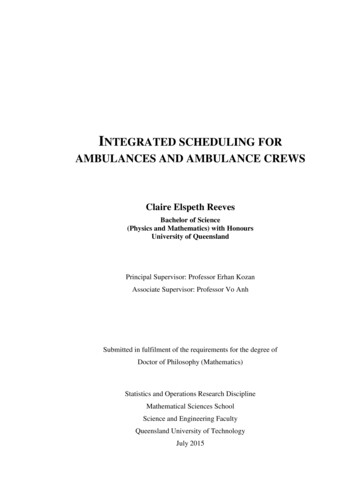
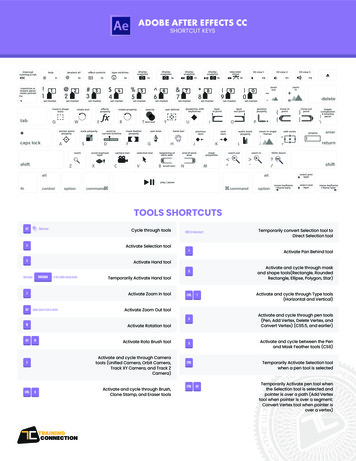
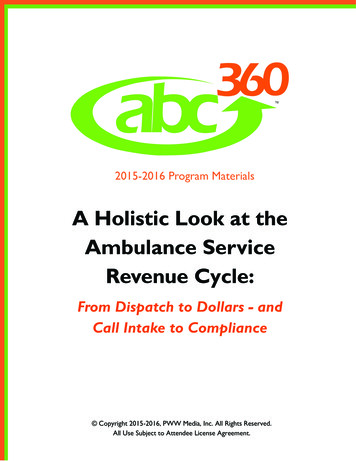
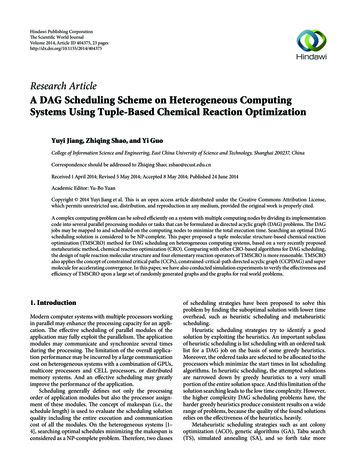
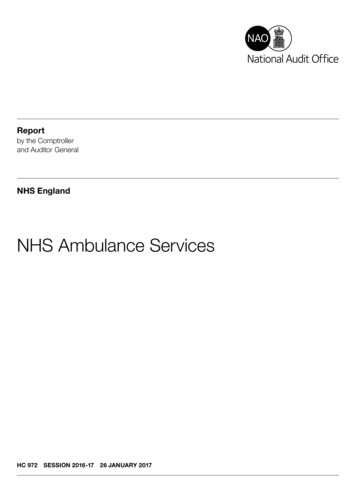
![MOH STANDARDS FOR EMERGENCY AMBULANCE SERVICE (2017) [Updated 21 Nov 2018]](/img/51/emergencyambulancestandards.jpg)
